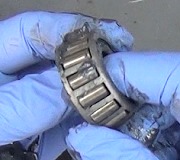I am so happy to see that you torque the lug nuts. Most do-it-yourselfers and some inexperienced mechanics do not understand how important that is, especially on smaller light-weight cars. In this case, it is pretty likely the damage was done by the previous person who over-tightened the lug nuts. You found they were too tight. That would have peeled the threads, then, when trying to loosen the nuts, the chips in the threads made the nuts bind, and the studs twisted off. Sometimes we manage to get the nuts to spin, but they do not thread off the studs. Those nuts have to be cut off, and that often includes damaging the wheel to the point it cannot be reused.
I did not get what you were referring to about the length of the studs or assuming some were stretched. I would not rely on that observation to draw any conclusions. Due to production tolerances, it is common to find the studs vary in length a little. What I would look at closely is the rounded contact patch on the wheel where the nut hits it. Those surfaces on the nut and the wheel must match perfectly because its the friction between them that holds the nut tight. That area may be torn up by the nut that was over-tightened. If you find that, it is likely no new nut will stay tight.
Be aware too that most import vehicles come with anodized wheel studs that have a silver, light blue, or light yellow coating. That coating is a lubricant. Do not put any type of grease on them as that will eat away that coating. That can also cause the nuts to bind and the threads to be peeled off.
If you have regular wheel studs with no anodized coating, it is okay to put a very light film of grease on the threads, but be careful as more is not better. Some people will throw a big glob of grease on the stud, then use an air impact gun to run the nuts on. Doing it that way will cause that wad of grease to build up in front of the nut, then get flung out onto the friction surface where it will get stuck between the wheel and the nut. We do not want any grease on those surfaces. If you put that much grease on a stud, walk the nut on by hand all the way, then torque it as you normally do.
Also, as long as I am spouting off warnings, do not ever use anti-seize compound on wheel studs. Doing that will get a mechanic fired. Grease keeps the threads from rusting but it lets the friction keep them tight. Anti-seize compound eliminates that friction, then the bouncing of the tires will work the nuts loose. You can use anti-seize compound on the wheel's center hole to make removal next time easier, especially with cast aluminum wheels that like to corrode to the hub, but I prefer to avoid this stuff all together, just to be safe.
Saturday, June 9th, 2018 AT 7:42 PM



